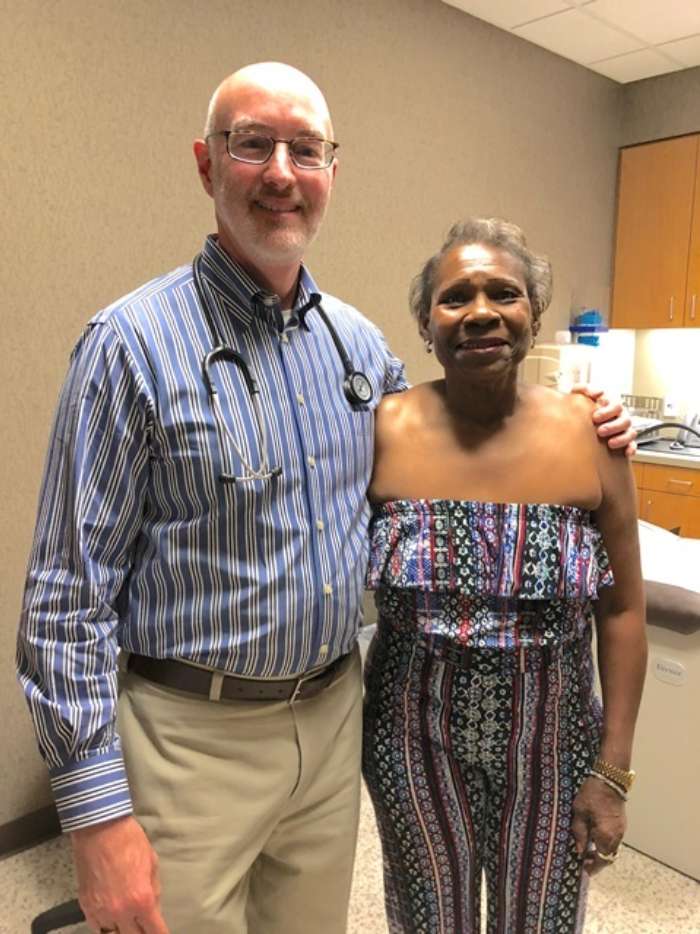St. Luke's Health joins CommonSpirit.org soon! Enjoy a seamless, patient-centered digital experience. Learn more

Shirley Lewis (right) is pictured with Radiation Oncologist and Medical Director of the Temple Cancer Center Dr. Sid Roberts (left). Lewis was the first patient treated with SBRT at the Temple Cancer Center in Lufkin.
A first for the Deep East Texas area happened this month at the Temple Cancer Center at St. Luke’s Health-Memorial in Lufkin. A new, sophisticated cancer treatment known as stereotactic body radiation therapy, or SBRT, was used to treat a small lung cancer in a patient who could not have surgery. Dr. Sid Roberts and his team at the Temple Cancer Center have been training and preparing to implement this new technology over the last two years.
Stereotactic body radiation therapy (SBRT), also known as stereotactic ablative radiotherapy, administers extremely precise, very intense doses of radiation using many beams aimed at different angles to precisely target the tumor. SBRT involves the use of sophisticated image guidance that pinpoints the exact three-dimensional location of a tumor so that the radiation can be more precisely delivered to the cancer while sparing surrounding tissue. This type of treatment was not possible prior to the advent of powerful treatment planning computers and highly sophisticated, computerized radiation treatment machines called linear accelerators that can target tumors with sub-millimeter precision.
At the Temple Cancer, Dr. Roberts, who specializes in radiation therapy for cancer (also called a radiation oncologist) and a physicist who specializes in radiation use a highly sophisticated computerized system to shape the radiation beams to match a three-dimensional outline of the tumor. This outline is generated by a four-dimensional CT scan, which is done to plan the procedure. “The precision of this treatment is incredible. We are, in reality, destroying a tumor very precisely while protecting the surrounding normal tissue,” said Dr. Roberts.
Stereotactic body radiation treatments are usually given as a single dose or up to five doses once or twice a week, although this can vary depending on the type and location of the tumor and the patient’s physical condition. The best candidates for this procedure are patients with small, well-defined tumors who cannot tolerate surgery. Small, early-stage lung cancers that can’t be removed surgically are a prime example.
SBRT is performed while the patient lies precisely cradled on the treatment table. Imaging technology on the linear accelerator helps ensure the patient is in the same position for every session and that the target area does not shift during treatment. The procedure usually takes between 30 minutes and an hour. Most routine cancer patients come for a period of five to nine weeks; SBRT patients come for a total of no more than five days, but receive a much higher effective dose of radiation in a short timeframe.
Preserving healthy tissue is important for cancer patients whose tumors are near or in essential organs.
“In lung cancer patients – especially those who have severely damaged their lungs with decades of smoking – they often do not have enough normal lung tissue to even have surgery; surgery is too dangerous,” Dr. Roberts said. “SBRT can provide a change to cure them just as if they had surgery, but with fewer side effects or complications.”
Shirley Lewis, the first patient treated with SBRT at the Temple Cancer Center in Lufkin, is a perfect example. Her lung cancer was small and had not spread yet, but she was not healthy enough to undergo surgery. Removing part of her lung would leave her too short of breath, and the risk of dying was felt to be too high. With SBRT, she has an 80% chance of being cured without having to have surgery. Ms. Lewis just completed her fifth and final radiation treatment, and is doing great.
Dr. Roberts will be seeing her regularly to follow up and get scans to verify that the cancer is gone and doesn’t come back. Without the technology here in Lufkin, she would have had to travel to Houston, Shreveport, or Tyler to get this treatment done.
Publish date:
Monday, April 30, 2018Looking for a doctor? Perform a quick search by name or browse by specialty.